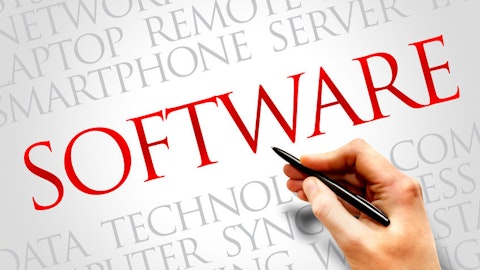René Lacerte: Thank you, William. It’s – when we think about how the suppliers are addressing, there’s a long tail of suppliers. They’re small suppliers, there’s large suppliers. By the way, suppliers are both on the international side as well as the virtual card side. And the opportunities to serve them are different. So when we look at the impact that we’re seeing today, there are opportunities for us to address and, like I said, pull in the road map to drive more payment choice across the portfolio. And so the first thing we’re going to do is focus on pulling in that road map. And then we’ll continue to create operating leverage using the strong payment economics we have to drive adoption. And then we’ll obviously leverage the integrated platform to drive adoption of payment products.
So lots of opportunities to kind of continue to drive the penetration of our payment products specifically on the specific question of suppliers potentially opting out, I’ll let John take that one.
John Rettig: Yes. So to that point about Ken, the trends that we’ve seen recently reversed or revert to or were back to a more linear increase in adoption. We think that’s absolutely the case. So we’ve seen numerous areas where product improvements can really help us drive adoption. Those are becoming more important in this macro environment than they were, say, a year ago or two years ago when adoption was increasing roughly. An example would be – we have a number of transactions for virtual cards that go unprocessed or even rejected and part of the reason for that is not actually cost. It’s that we’re not passing rich enough data in some instances to drive automated reconciliation. And so when René mentioned accelerating some of the product improvements, we are going to make enhancements to remove as much friction as possible from – and that was just one example from our ad valorem payment suite to make it easier for suppliers to adopt payments.
We also have the ability just within the unified platform, and I mentioned pricing and packaging earlier. We can look at the whole relationship that we have with suppliers now offer them more tools and capabilities and increase the value proposition that we’re delivering for them. If that involves incentives, if that involves payment speed, other product enhancements, we’re going to be leaning into all of that. And we think within this fiscal year, we’ll start to see a change in increasing volumes on some of these payment products.
William Nance: Got it. That’s super helpful. And then just maybe a question, maybe you could just put some numbers around sort of the exposure to more cyclical payment volume streams. It sounds like you guys have called out T&E is a strong – kind of a stronger area of spend, digital advertising, weaker, things like lease and rent weaker. So just maybe if you could put some numbers around kind of like the overall size and any other categories that we call out as we kind of try to separate out like more versus less cyclical streams of payment volume.
John Rettig: Yes. I mean we haven’t provided specific percentages or things on spend categories other than to say, just like we serve customers across all industries, we have a pretty diversified base of expenses across customers as well because we generally have, call it, 70 or 80 or more percent share of wallet. So we’re seeing all types of spend. In the case of T&E, that’s what I called out specifically around card spend. That’s still small relative to the total base of spend, which was $4 billion in the last quarter for our Spend and Expense product. But it’s large enough that like that movement, we’re seeing strength there. It stands out because most other categories are flat to slightly down. Now even T&E is still down on a per transaction basis.
So the card spend per transaction. And I’d say the same is true with the example on the AP automation side with lease payments and rent and everything that is facilities related that’s like low single digits percent of a company’s overall spend on average, but we are seeing aggressive reductions in that category as companies rethink small businesses rethink their physical footprint in this environment.
William Nance: Got it. Super helpful. Appreciate all the color, guys.
John Rettig: Thank you.
Operator: Thank you. Our next question comes from Andrew Schmidt from Citigroup. Andrew, your line is open. Please go ahead.
Andrew Schmidt: Hey René. Hey John. Thanks for taking my questions. I just want to dig back into the SMB health topic. And it sounds like retention characteristics, engagement are still pretty strong, but are you seeing any changes around involuntary attrition maybe on the smaller side of the business spectrum, more businesses is going on business, things like that. I would love to dig a little bit more into that front just on the SMB Health. Thanks a lot guys.
René Lacerte: Yes. Thank you, Andrew. We are definitely seeing strong demand across the platform, 4,700 core net adds this quarter continues, obviously, good success in our financial institution category. So lots of opportunity to drive adoption. And when – I think John referenced from a retention perspective, we’re in a good spot. It’s nothing has changed from that perspective. It really is about businesses tightening their belt. And like we said, it’s the larger businesses that have the most ability to tighten their belt. And that’s where we’re seeing the spend – the Spend and Expense capabilities from the Divvy acquisition. Those tended to be larger businesses to begin with. And so that’s kind of where we see the impact is kind of the larger business and the SMBs as a whole, I mean, they’re adopting the platform, they’re using the platform.
The engagement is high. Everything that we are doing to make their lives easier comes through. That’s what we hear from our customers and why we include them in the call. This is something that we believe there’s an opportunity to continue to grow and expand and reach more businesses because of that – those types of adoption trends.
Andrew Schmidt: Got it. Thank you very much René. And then with the completion of the unified platform, I’m sure that frees up a lot of internal bandwidth resources, things like that. Can you talk about how you redeploy those resources, whether it’s additional product velocity, go-to-market? Anything around that front would be helpful. Thank you.
René Lacerte: Yes. Another great question. A lot of what we’re focused on is how do we continue to iterate faster and expand the portfolio of the payment products we have, that enhance the customer experiences that we have. So with the integration of the platform into one, there’s now one unified experience across mobile and desktop that we did not have before. Now that’s not out for all customers, but it is rolling out to our customers. On the mobile experience, for example, over the next few quarters here. So lots of opportunity to kind of enhance and iterate faster because like you said, it was a heavy lift. I was super happy that we got it done ahead of schedule. Originally, we had said we’d get it done by the end of calendar 2024.





